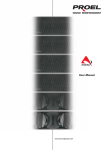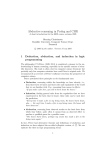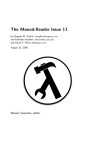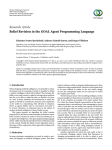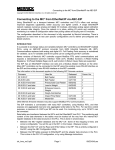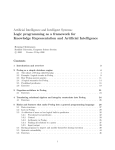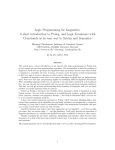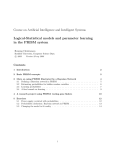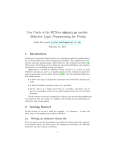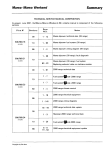Download G. Terreni. The CIFF System: an Overview. Technical Report.
Transcript
The CIFF System: an Overview Giacomo Terreni Dipartimento di Informatica, Università di Pisa Email: [email protected] Abstract. This paper details the structure and the main algorithms in the CIFF System 4.0, a SICStus Prolog implementation of the CIFF proof procedure. 1 The high-level design of the CIFF System The CIFF System 4.0 requires SICStus Prolog 3.11.2 (or newer versions of SICStus Prolog 3 release) and it starts by compiling, on the Prolog top-level shell, the ciff.pl file which, in turn, compiles all the CIFF System modules. The CIFF System is composed by the following modules: – the main module1 : it provides the main predicate (run ciff/3) for starting a CIFF computation and it manages the main computational cycle, – the flags module: it provides all the CIFF flags an user can set to change the CIFF behavior (e.g. turning on/off the NAF module, the level of debugging info returned to the user and so on); all the flags are detailed in the CIFF manual [8], – the preprocess module: it provides the translation from the user’s abductive logic program with constraints to its internal representation, – the proc module: it provides the predicate sat/2 which, roughly speaking, implements the CIFF proof rules, – the proc-aux module: it provides auxiliary predicates to sat/2, – the aux module: it provides general auxiliary predicates, – the constraints module: it provides the wrapper around the SICStus CLPFD constraint solver, – the debug module: it provides predicates to return debugging info to the user, and – the ground-ics module: it provides an efficient algorithm for handling some classes of integrity constraints (see Section 7). Once compiled the system, a CIFF computation starts with the run ciff/3 call:2 1 2 Each “module” is implemented in a .pl file having the same name with a ciffprefix. E.g. the ciff-main module is implemented by the ciff-main.pl file In what follows, we will use several Prolog standard notations: variables names start with capital letters, ! is the cut operator, [ ] is the notation for lists and \+ stands for negation. Moreover the notation pred/n stands for “the predicate pred with arity n” and finally +,- before a predicate argument Arg represent that Arg is an “input” argument and an “output” argument respectively. | ?- run_ciff(+ALPFiles,+Query,-Answer). where ALPFiles is a list of .alp whose conjunction represents an abductive logic program with constraints (ALPC) and Answer is the output variables which will be instantiated to the CIFF extracted answers (if any) to the list of literals provided in Query. The possibility of specifying more than one .alp in the ALPFiles list is to facilitate the user in writing CIFF applications. A typical example is a two terms list where one .alp file contains the clauses and the integrity constraints which specify the problem and the other file contains the specification of the particular problem instance. In this way the first file could be reused for others instances. A CIFF computation is composed by both a preprocessing phase which both translates ALPFiles into its internal representation and initializes the system data structures and an abductive processing loop implemented as a recursive call to the sat/2 predicate. Each call to the sat/2 represents an application of a CIFF proof rule and at the end of the loop Answer is instantiated either to a CIFF extracted answer or to the special undefined (if the Dynamic Allowedness rule has been applied). Further answers can be obtained through Prolog backtracking. If no answer has been found, the system fails returning the control to the user. The main CIFF computational cycle is described in the following picture. Fig. 1. The CIFF System: main computational cycle The preprocessing phase, detailed in Section 2, stores the iff-definitions derived from the user program into an internal representation in which the various ele- ments are maintained in disjoint sets depending on their type: abducibles, defined atoms, constraints, equalities and so on. The same type-based partition is performed on the first CIFF node of the computation, composed by the conjunction of the integrity constraints in ALPFiles and the Query. This node is passed as the first input of the sat(+State, -Answer) predicate, where State is the state of the CIFF computation, which is composed by the representation of the current CIFF node plus other auxiliary run-time information, in particular for NAF (see below). A CIFF node is represented by a state atom of the form: state(Diseqs,Constraints,Implications,DefinedAtoms,Abducibles,Disjunctions) where the arguments represent the CIFF conjuncts of the node. They are maintained aggregated, depending on their “type” (and their names are quite selfexplanatory): Diseqs represents the set of CIFF disequalities, Constraints represents the current finite domain constraint store, Implications the set implications, DefinedAtoms the set of defined atoms, Abducibles the set of currently abduced atoms and finally Disjunctions represents the set of disjunctive CIFF conjuncts. Each element in Disjunctions represents a choice point of the computation and when the Splitting rule is applied on it, the current CIFF node is selected in a CIFF formula following the left-most criteria. When the computation on a certain node ends (instantiating Answer or failing), the next node is selected via Prolog backtracking. Delegating the management of the switching among CIFF nodes to the Prolog backtracking allows to maintain in the current State only the information of the selected CIFF node and, for performances, it is the only possible practical choice. Each sat/2 clause represents the implementation of a CIFF proof rule and it has the following general structure: 1. a first part to search for a rule input in the node satisfying the applicability conditions of the implemented proof rule 2. a second part for applying the rule and updating the State 3. a recursive call to sat/2 with the updated State. The search for a rule input is done scanning sequentially the CIFF conjuncts in the current node. Thus, maintaining a type-based partition of the CIFF conjuncts throughout a computation plays a very important role in terms of efficiency and clarity of the code. This is because each CIFF proof rule operates on certain types of CIFF conjuncts (e.g. the Unfolding atoms rule operates on defined atoms, the Factoring rule operates over abducibles and so on) and that separation facilitates the search for a rule input among the CIFF conjuncts. If such a rule input has been found, the concrete application of the rule is performed (relying upon the procaux, aux and constraints modules, also depending on the given proof rule), and the State is updated. Implementing the proof rules as sat/2 clauses, implies that, due to the Prolog semantics, the order of these clauses determines the priority given by the CIFF System to a certain proof rule during the computation. Roughly speaking, the system tries to apply the proof rule implemented in the first sat clause, if no rule input is found, then the following sat clause is tried. If no rule can be applied to a node and no inconsistencies have been detected, an abductive Answer is extracted and then returned to main module. When all the choice points have been traversed, the CIFF computation ends returning the answer no to the user indicating that no more answers can be found. What described above outlines the implementation of the CIFF selection function. We use a classical Prolog-like selection function, i.e. we always select the left-most CIFF node in a CIFF formula. It is not a fair selection function in the sense that it does not ensure completeness (see [6] for further details), but it has been found as the only possible practical choice in terms of efficiency (in both time and space) taking advantage of Prolog backtracking. Concerning the order of selection of the proof rules in a CIFF node, this is determined by the order of the sat clauses. If a sat clause defining a CIFF proof rule, e.g. Unfolding atoms (R1), is placed before the sat clause defining, e.g. Propagation (R3), then the system tries to find a rule input for R1 and if no such rule input can be found, then the system tries the same for R3 and so on. Further details on this topic are given in Section 5. However, some CIFF proof rules, in particular those rules regarding equalities (Substitution in atoms, Equality rewriting in atoms and so on) and the most part of the Logical simplification rules, are not implemented each one as a sat/2 clause. Rather they are “embedded” in the other main CIFF proof rules, i.e. when a proof rule R, e.g. Unfolding atoms, is applied, the system first determines all the operations on the equalities and the logical simplifications “arising” from R and then it performs them immediately. Thus the updated State is not only derived from the application of R but also from the application of all the other “embedded” proof rules. This point, as detailed in Section 3, determines a great enhancement of performances and moreover it allows for a better readability of a CIFF computation for debugging purposes. Until now we do not have taken into account the NAF module whose details will be described in Section 6. Just to have a global picture of the system, the implementation of the NAF extension, following the specifications given in [6], can be logically split in two parts: one part which handles the marked integrity constraints and the production of the prv atoms and the second part,i.e. from the application of the NAF Switch rule onward, checking the so-far produced prv atoms avoiding new abductions through the NAF factoring rules. Whether the NAF extension is activated or not the preprocessing phase changes accordingly producing marked or non-marked implications in the first node. In the same way NAF proof rules (implemented again as sat clauses) are taken into account or not by the system. The NAF extension is activated through a CIFF flag and it requires a distinct preprocessing for integrity constraints accordingly to the CIFF¬ specifications. Moreover the State argument of sat, to embrace the NAF extension is a twoterms structure as follows: state(Diseqs,Constraints,Implications,DefinedAtoms,Abducibles,Disjunctions): naf_state(DeltaNAF,NAFSwitch) where DeltaNAF represents the marking set of a CIFF¬ node and NAFSwitch is a 1/0 flag indicating whether the NAF Switch rule has been applied or not. The interactions of the modules in a CIFF computation is displayed in Figure 2. Fig. 2. The CIFF System: modules interactions In the rest of the chapter, we detail the main interesting parts of the system together with the solution adopted, avoiding to describe the CIFF System “lineby-line” from begin to end. We start from the preprocessing phase together with a description of the user input and the returned answer. Then we describe, in Section 3 and in Section 4, the management of both variables (in particular their quantification) and constraints. In Section 5 we discuss about the loop checking routines in the CIFF System. In Section 6 we describe the issues in the implementation of the NAF extension and finally in Section 7 we describe the ground-ics module containing an efficient algorithm for evaluating some classes of integrity constraints. 2 Input Programs, Preprocessing and Abductive Answers As said in the previous section, a CIFF run starts with a run ciff(+ALPFiles,+Query,-Answer) call where the conjunction of the .alp files in the ALPFiles list represents the user-defined abductive logic program with constraints. Each abductive logic program with constraints (ALPC) consists of the following components, which could be placed in any position in any .alp file: – Declarations of abducible predicates, using the predicate abducible. For example an abducible predicate abd with arity 2, is declared via abducible(abd( , )). – Clauses, represented as A :- L1, ..., Ln. – Integrity constraints, represented as [L1, ..., Lm] implies [A1, ..., An]. where the left-hand side list represents a conjunction of CIFF literals while the right-hand side list represents a disjunction of CIFF atoms. Equality/disequality atoms are defined via =, \== and constraint predicates are #=, #\=, #<, #>, #=<, #>= together with the domain inclusion predicate in (e.g. X in 1..100). Finally, negative literals are of the form not(Atom) where Atom is an ordinary atom. Example 1. The following is the CIFF System representation of the “grass” Example presented in [5]. % Abducibles: abducible(sprinkler_was_on). abducible(rain_last_night). % Definitions: grass_is_wet :- rained_last_night. grass_is_wet :- sprinkler_was_on. shoes_are_wet :- grass_is_wet. % ICs: [rained_last_night] implies [false]. Let assume that the file is named grass.alp. The following is the call to run CIFF on the query shoes are wet: run_ciff([grass],[shoes_are_wet],Answer). 2 Example 2. The following is the CIFF System representation of the “lamp” Example presented in [3]. % Abducibles: abducible(empty(_)). abducible(power_failure(_)). % Definitions: lamp(a). battery(b,c). faulty_lamp :- power_failure(X), not(backup(X)). backup(X) :- battery(X,Y), not(empty(Y)). Let assume that the file is named lamp.alp. The following is the call to run CIFF on the query f aulty lamp: run_ciff([lamp],[faulty_lamp],Answer). 2 The preprocess module translates both ALPFiles and Query and stores them into their internal representation. We can logically split the user input in two main parts: a static part (iff-definitions) and a dynamic part (query plus integrity constraints). The main objectives in preprocessing are to separate elements of both input parts depending on their types (as discussed in the previous section) and to store the static part in order to efficiently retrieve the information when needed at run-time. Each iff-definition is stored in the Prolog global State (through an assertion) in the form of iff_def(+PredName, +Arguments, +Disjuncts) where PredName is the name of the predicate, Arguments is a list of N distinct variables (where N is the arity of the predicate) and Disjuncts is the list of disjuncts in the form disj(+Constraints,+Equalities,+Diseqs,+Implications,+DefinedAtoms,+Abds) where the list of Implications is obtained transforming the negative literals in the clauses in implicative form whose internal representation will be discussed later. For example the clause p(X,Y,d) :- X #> 5, a(Y), q(Z), r(X), Y \== Z is translated into (assuming that a/1 is abducible and the above clause is the only clause for p/3): iff_def(p,[X,Y,W],[disj([X#>5],[W=d],[Y\==Z],[],[q(Z),r(X)],[a(Y)])]). Suppose now that during the computation, we have to unfold p(2,b,d). To retrieve the iff-definition of tt p/3 we simply call: iff_def(p,[2,b,d],-Disjuncts) where Disjuncts in this case will be: [disj([2#>5],[d=d],[b\==Z],[],[q(Z),r(2)],[a(b)])] In this way we have both a direct access to the iff-definitions and a clear separation of the elements by their type in order to update efficiently the current State when needed. Integrity constraints, instead, are not stored in the Prolog global state as they, together with the Query, will represent the first CIFF node of the computation. However, in the internal representation, their components are again separated depending on their type as follows: body(BCons,BEqs,BAts,BAbds) implies head(HCons,HEqs,HDiseqs,HAts,HAbds) Consider the integrity constraint [not(c), q(Y), p(X), r(Z), X=Y, X\==Z] implies [false] Its internal representation (assuming r/1 is abducible) is body([],[X=Y],[q(Y),p(X)],[r(Z)]) implies head([],[X=Z],[],[c],[]) This is because the preprocessing phase translates the negative elements into their positive form (including disequalities, transformed into equalities) and put them into the head, eventually removing false3 . The implicative form of negative literals in the clauses, e.g. not(p), is as follows. body([],[],[p],[]) implies head([],[],[],[false],[]) The above representation may seem quite complex, but it allows for maintaining a type-based separation, thus avoiding many run-time routines of type-checking. The dynamic part of the input represents the State argument of the sat/2 predicate: state(Diseqs,Constraints,Implications,DefinedAtoms,Abducibles,Disjunctions) 3 Note that, for now, we do not take into account the NAF extension. When we will describe the NAF extension we will slightly change this representation because, body negative literals into the body of a marked integrity constraint have to stay in the body. where all the components arise from the various conjuncts in the Query, apart Implications which is composed of the conjunction of all the preprocessed integrity constraints and the implicative form of the negative literals in the Query. The last remarks of this section are about the form of an abductive Answer. A CIFF extracted answer is represented by a triple, namely a list of abducible atoms, a list of CIFF disequalities DE and finally a list of finite domain constraints Γ . The set of equalities E is not returned as the final substitution (in E) is directly applied by the system. Abducibles:Disequalities:Constraints:Labels The Labels component, be discussed in Section 4, contains a consistent assignment (or a labeling) of the constraint variables in Constraints and it is an added feature of the implementation with respect to CIFF specification. Example 3. The only CIFF extracted answer of the Example 1 is: [sprinkler_was_on]:[]:[]:[] The two answers of the Example 2 are: A1 = A2 = [power_failure(b),empty(c)]:[]:[]:[] [power_failure(_A)]:[_A\==b]:[]:[] 2 3 Variables Handling Variables play a fundamental role in both the theory and the implementation of the CIFF proof procedure. The presence of both existentially quantified and universally quantified variables is difficult to manage at both levels. We recall that in a CIFF node, a universal variable U is a variable which occurs only in an implication which also defines the scope of U , while an existential variable E is a variable occurring in at least a CIFF conjunct which is not an implication and the scope of E is the whole CIFF node. In this section we focus on two issues: checking variable quantification at run-time and the implementation of the proof rules concerning equalities, i.e. Equality rewriting and Substitution rules. To simplify the presentation, we refer to those rules as to equality rules. The main issue in variable quantification is that existentially quantified variables may occur inside an implication due to a propagation rule application. The implementation of a CIFF proof rule managing implications must take into account that a variable can be either existentially or universally quantified, in order to avoid unintended behaviors. Thus, the CIFF System must know at run-time the quantification of a variable and moreover, as it is largely required throughout a CIFF computation, there is the need of an efficient access to this information. The solution adopted is to associate to existential variables the existential/0 attribute. The mechanism of attributed variables ([4]), i.e., roughly speaking, “appending” some information (attributes) to a variable, allows for determining variable quantification in a fast and reliable way through a local access to the variable itself. The idea is very simple: all the variables occurring outside the Implications argument of the current State have the existential attributed associated with; during the application of a CIFF proof rule, the existential attribute is associated to each variable moving from an implication to outside. In this way at the end of each CIFF proof rule application, we have two disjoint sets of variables: the set of existentially quantified variables (with the existential attribute) and the set of universally quantified variables (without attributes). As said in Section 1, equality rules are implemented at the end of the other main proof rules. For example, consider to unfold a CIFF conjunct p(X,Y) in a CIFF node such that the iff-definition of p/2 is: iff_def(p, [Arg1,Arg2], [disj([],[Arg1=a,Arg2=b],[],[],[],[])]). Following the CIFF specifications, unfolding will result into the set of equalities X=Arg1, Y=Arg2, Arg1=a, Arg2=b. Successively, this set has to be simplified and propagated to the whole node by applying a number of “variable” CIFF proof rules. In the CIFF System, instead, the latter operations are done all-in-one, simplifying locally the set of equalities resulting from the application of a CIFF proof rule and then propagating the resulting set of substitutions to the node (in case of existentially quantified variables) or to the implication (in case of universally quantified variables). In doing this, the system takes advantage of the underlying Prolog unification as much as possible. Following CIFF specifications, equality rules rely upon a slightly modified version of the Martelli-Montanari unification algorithm [7] and the problem in using Prolog unification is again related to variable quantification: being all the variables existentially quantified, from a Prolog point of view, Martelli-Montanari conditions on variables quantification cannot be checked by Prolog itself. Due to this, the implementation of the equality rules relies on: – Prolog unification for all the equality rules not involving implications: this is because in that case all the variables are existentially quantified, hence the Prolog unification is able to manage them; – an explicit implementation of the Martelli-Montanari algorithm (in the procaux module) otherwise Addressing equality rules at the end of the other main proof rules brings some important benefits. The first one is efficiency. Performing all at once those operations at the end of a main proof rule grants an immediate and local access to those variables which need to be unified/propagated and, moreover, the absence of dedicated sat clauses for those rules avoids searching for suitable equalities in the current CIFF node to be unified/propagated. To give an idea, in a typical abductive logic program, each main CIFF proof rule gives out the preconditions to the application of 4-5 equality rules: this would have required a correspondent number of CIFF iterations. Not surprisingly, this point together with taking advantage as much as possible of Prolog unification boosts significantly the performances of the system (execution times of CIFF System 3.0 were approximately halved). Note also that the use of Prolog unification for existential variables makes useless to maintain the equalities as CIFF conjuncts in the current State. This is because at the end of a proof rule all the possible substitutions have been exhaustively applied. Finally, dropping equality rules from the main sat loop brings also a great enhancement in debugging. This is because for a human eye, even an expert human eye, it is much easier to follow the trace of a CIFF computation without a “verbose” application of equality rules. Consider again the example above. With a verbose application of equality rules we would have: 1 - p(X,Y) 2 - X=Arg1, Y=Arg2, Arg1=a, Arg2=b 3 - X=a, Y=Arg2, Arg1=a, Arg2=b ... Instead, applying all-at-once the equality rules we simply obtain: 1 - p(X,Y) 2 - X=a, Y=b It is obvious that in a CIFF node with tens of CIFF conjuncts and tens of variables a “verbose” application of equality rules leads to a untraceable computation! 4 Constraints Handling The management of CLP constrains is another big implementation issue of the CIFF System. The SICStus CLP constraint solver for Finite Domains (CLPFD solver ) is a state-of-the-art constraint solver [2] and its interface to the standard Prolog engine is quite simple and effective. However, as it happens in general with constraint solver implementations, given a ceratin constraint store, the only way to know about its satisfiability is performing an exhaustive checking (or labeling) of the involved constraint variables. This implies that during a CIFF computation, the constraint store is not ensured to be consistent, unless labeling is performed. Labeling is an expensive operation on big constraint stores, hence it should be used carefully during a CIFF computation. Applying frequently the constraint solving rule to exhaustively check the constraint store could not be a good practical solution because if on one side some CIFF branches can be cut if the store is unsatisfiable, on the other side the overhead due to labeling could be very big. The choice we did in the system is to perform labeling every N CIFF proof rules applications, where N is modifiable by the user through a CIFF flag. A further check is always performed at the very end of a CIFF branch computation, when no other proof rules can be applied to the current node and before an answer is returned to the user. Apart from efficiency issues, the main problem in using labeling during a CIFF computation is that labeling results in a complete grounding of the constraint variables, thus, the constraint store in the CIFF extracted answer would be totally ground. To solve this issue, the simplest solution is to build, on-the-fly, a working copy of the constraint store with fresh constraint variables and then to perform labeling on that working copy. If the constraint store is unsatisfiable the current CIFF branch fails, otherwise the computation goes on with the original copy. But this does not work in practice because copying a constraint store is a very expensive operation in terms of both space and time and it is not reliable. Instead, the solution we adopted is able to perform labeling maintaining a single copy of the constraint store by using a backtracking-based algorithm which, when needed, checks the satisfiability of the CLP store through a labeling and then it restores the non-ground values via a forced backtracking. Surprisingly, this is the best solution, to our knowledge, for efficiency and memory usage which allows both satisfiability checks and non-ground answers. Now we sketch the implementation of that backtracking-based algorithm. We assume to apply it at the last CIFF step in a branch, before to return an abductive answer to the user. The following is a piece of the sat last clause. %%%Final clause: returns an answer if the solver succeed S1 sat( State, Answer) :S2 ... S3 !, S4 (label_flag(0) ; label_flag(1)), S5 run_time_label(CVars), S6 make_label_assocs(CVars,0,Assocs), S7 ... The symbol ; at line S4 represents a disjunction with the “standard” backtracking semantics of Prolog: if label flag(0) succeeds, the disjunction becomes a backtracking point and label flag(1) is evaluated in case of failure later on. The predicate label flag represents whether labeling has been performed on this store (label flag(1) succeeds) or not yet (label flag(0) succeeds). It is asserted, with value 0, in the Prolog global state at CIFF System initialization as follows: assert(label_flag(0)). The asserted value of label flag is then used in run time label(CVars) which effectively performs the labeling on the constraint variables CVars. The predicate in line S6 regards the added component in the implementation of a CIFF abductive answer: the association of a ground solution for the constraint variables and it will be discussed later on. The run time label/1 predicate is defined as follows4 L1 L2 L3 L4 L5 L6 L7 L8 L9 L10 L11 L12 L13 L14 L15 L16 L17 run_time_label(CVars) :labeling_mode(Mode), retract(label_flag(V)), if (V = 0) { if (labeling(Mode,CVars)) { assert_label_list(CVars,0), assert(label_flag(1)), !, fail } else { assert(label_flag(0)), !, fail } } else { assert(label_flag(0)) }. Mode in line L2 represents one of the labeling algorithms offered by the SICStus CLPFD solver [1]. It can be set through the labeling mode CIFF flag. In line L3 the value V of label flag is checked (recall that in the sat clause both 0 and 1 are accepted by the system) and the atom is retracted from the global Prolog state. If V = 0 (the initial situation), the labeling (line L5) is performed. If it fails, the label flag(0) is asserted again and run time label fails too. The last assertion ensures that also sat fails because the disjunction in line S4 fails. Instead if the labeling succeeds, then label flag(1) is asserted, run time label fails again but when the control returns, via backtracking, to sat at line S4, it does not fail due to the presence of label flag(1) in the Prolog global state. Hence run time label is traversed again, the test at line L4 fails because now the 4 In real Prolog code the if-else statement is represented by the operators -> ; whose semantics ensures that the second branch is not a backtracking point if the first branch succeeds. For readability we use an “imperative-like” syntax. value of V is 1, and, before to succeed, label flag(0) is asserted again in order to restore the initial situation. Note that whenever the run time label clause fails, the variables in the constraint store are restored via Prolog backtracking. This happens also when the labeling succeeds. In this way, if labeling succeeds, and then label flag(1) is asserted, we are ensured that the current constraint store is satisfiable but constraint variables are not bound to ground values. The assert label list/2 predicate in line L6 simply asserts in the Prolog global state the numeric values returned by labeling. Those assertions are done maintaining the positional order of the list of variables CVars and they are used by the make label assocs to retrieve the consistent assignment to be displayed to the user together with the abductive answer. The other use of the algorithm (every N CIFF steps) is very similar. The only difference is that the assertions of the ground values are not performed and moreover, in the real code, there is a further flag for distinguishing whether it is the last step or an N th step. 5 Loop Checking and CIFF Proof Rules Ordering CIFF specifications do not ensure that a CIFF computation terminates. E.g., a CIFF computation for the query p with respect to the abductive logic program composed of the single clause p ← p, will loop forever applying infinitely unfolding. This example (and many other examples) has a theoretical justification: p is undefined under the three-valued completion semantics thus neither the query p nor the query ¬ p succeeds, leading to infinite looping. However, when switching from theory to practice, further non-terminating sources arise which do not have a theoretical justification. In this section we address four types of non-termination sources: – – – – the order of selection of CIFF nodes in a CIFF formula; the order of selection of the CIFF proof rules; the order of selection of CIFF conjuncts in a CIFF node; CIFF proof rules which cannot be applied twice in a CIFF branch. Both in the specifications and in the implementation, the number of leaf CIFF nodes in a CIFF formula can be incremented only by the application of Splitting on a disjunctive CIFF conjuncts. While, theoretically, any leaf node can be selected at any CIFF step, in the system we implemented the left-most strategy. This implies that, sometimes, abductive answers can never be returned to the user because the system loops forever in a non-terminating branch. This choice follows the classical Prolog approach and it allows for using directly the underlying Prolog backtracking in case of failures. The benefits are in terms of efficiency and simplicity because no additional machinery is needed to keep trace of non-selected nodes, while the main drawback is obviously the potential non-termination. However, we argue that managing even small-medium size CIFF applications, this approach is the only computationally feasible approach because managing branching without relying upon Prolog backtracking is computationally very expensive in both time and space. The second source of non-termination is the order of selection of the CIFF proof rules. Consider the abductive logic program composed of the clause p ← p and the integrity constraint a → f alse where a is an abducible predicate. A CIFF computation with the query p, a will loop forever if Unfolding atoms has a higher priority than Propagation. In this case the system applies infinitely many times Unfolding atoms on p while propagating a to a → f alse, would lead to an immediate failure. This is a main issue in implementing CIFF because in general there is no evidence of which rule has to be applied at each time in order to avoid non-termination, or at least to reduce the final size of a proof tree. Above the right choice was Propagation and it seems that setting a high priority to Propagation rule can prevent some non-terminating situations. However, in general Propagation is a computationally expensive rule because it increments the set of implications in a node which are a main source of inefficiency due to the presence of universally quantified variables. Hence, in many applications it could be better to give a lower priority to Propagation and in general to rules managing implications. As we said in Section 1 each CIFF proof rule is implemented as a sat/2 clause in the proc module. This was a central choice in the design of CIFF and that solution implies that each proof rule has a predefined priority during a CIFF computation and it corresponds to its order among the sat clauses. I.e. the system, at each iteration, tries to apply the proof rule represented by the first sat clause. If no rule input can be found in the node, the second sat clause is explored and so on. The last sat clause represent the fact that no rule can be applied on the node and then an abductive answer is returned to the user. It is clear that in certain cases, if the order of the sat clauses is “wrong”, this solution does not prevent non-termination. Nevertheless we think that this is a good practical solution because on one side it allows to have a modular implementation of the proof rules and on the other side it is possible to change the order of the rules simply moving up and down the sat clauses in the proc module, thus allowing for a simple domain dependent tuning of the system. The third potential non-termination source is the order of selection of CIFF conjuncts in a node. Consider an abductive logic program composed of the clauses p ← p and q ← f alse. The query p, q may not terminate Unfolding atoms p forever. However, if CIFF unfolds q, the query fails immediately. Note that the CIFF proof rule is the same but in one case CIFF does not terminate and in the other case it does. To prevent such behavior, the CIFF System implements a left-most selection strategy on the lists of typed CIFF conjuncts, but the insertion of new conjuncts is done at the end of the lists. Consider again the above example and let suppose to have, in the current State the list [p, q] of defined atoms. First CIFF selects p as the rule input for Unfolding atoms because is the first element in the list. The application of the rule will result in inserting again p in the list, but this is done at the end of the list. Thus the new list of defined atoms will be [q, p]. At the next CIFF step, q will be selected to be unfolded, thus leading to failure. We believe that this strategy represent a good compromise between efficiency and loop prevention. The fourth and last source of non-termination is represented by those CIFF proof rules which require an explicit loop-checking in the specification of a CIFF derivation, i.e. Factoring and Propagation5 . We first consider Factoring. To implement loop-checking for Factoring we added two numbers to each abducible CIFF conjunct in the current State: a unique identifier and a factoring counter. I.e. each element in the Abducibles argument of state is of the form: Abd:Id:FactCounter where Id is a unique system-generated integer while FactCounter indicates the least abducible Abd’ (i.e. the abducible with the least identifier) such that Abd and Abd’ have not been factorized yet. The list of abducibles is maintained ordered with respect to the identifiers throughout the computation and when a new abducible is inserted in the list, its FactCounter is initialized to 1 When Factoring is selected, the system selects a pivot abducible atom Abd:Id:FactCounter which is the abducible with the least Id such that FactCounter < Id. If no pivot is found then all the pairs of abducibles have already been factorized. Otherwise, if Abd is found then the least abducible Abd’:Id’:FactCounter’ such that FactCounter <= Id’ < Id is searched for. If there is such an Abd’, then Abd and Abd’ are factorized and FactCounter is set to Id’ else FactCounter is set to Id + 1 and the next pivot is selected for Factoring. Example 4. Consider the following three abducibles in the current State and let us assume that no Factoring rule has been applied yet in the branch (FactCounter is set to 1 for all the abducibles): a(X):1:1 a(Y):2:1 a(Z):3:1 When Factoring is selected for the first time, a(X) is not selected as a pivot because 1 = 1. Instead a(Y) is selected and it is factorized to a(X). This is because 1 <= 1 < 2. Then the FactCounter of a(Y) is set to 1 + 1 = 2. We obtain: 5 Note that in CIFF specifications, also other rules concerning equalities need loopchecking. This is obtained “for-free” in the implementation by performing them at the end of the other proof rules. a(X):1:1 a(Y):2:2 a(Z):3:1 At this stage only a(Z) can be selected as a pivot and it is factorized first to a(X) and then to a(Y) obtaining: a(X):1:1 a(Y):2:2 a(Z):3:3 At this point no abducible can be selected as a pivot and, indeed, all the pairs of abducibles have been factorized. Note that, given a pivot abducible, only those elements which precede it in the list are considered for Factoring. This is because each pair of abducibles have to be factorized only once in a CIFF branch. If for each pivot we have would considered all the abducibles in the list, each pair of abducibles would have been factorized twice. Following the specifications, when two abducibles are factorized, e.g. a(X) and a(Y), in one successor CIFF node the two abducibles are still in the list and the disequality X ¯ = Y is added to the current State, while in the other successor CIFF node, the pivot abducible is deleted from the list and the substitution Y = X is applied to the whole State. If the two abducibles are both ground, then only one successor node is computed and if they are equal, the pivot is simply deleted. The loop checking for propagation is a bit more complex. In order to perform a loop checking for Propagation which follows exactly the specifications, we need to maintain a data structure, for each implication in the current State, containing all the CIFF conjuncts (abducibles and defined atoms) to which that implication has been propagated to. This data structure can be very big and checking whether an element occurs in it could be very expensive, and the situation is worsened by the presence of existentially quantified variables. Suppose to have a CIFF conjunct p(X) in the State and the clause p(X) ← p(Y ) in the input program which, when applied by Unfolding atoms, introduces a fresh existential variable in the node. I.e. the atom p(X) is unfolded to p(X1), then to p(X2) and so on. Each implication containing p(Z) in its body, has to be propagated to each atom p(Xi) because the Xi variables are all distinct. Obviously, maintaining for each implication in a node, that structure and checking against it each potential CIFF conjunct to be propagated to, implies a huge overhead in terms of efficiency. Our implemented solution avoids such overhead, paying something in terms of completeness. The two main ideas are that (1) in most practical cases, Propagation can be applied only to abducible CIFF conjuncts and (2) if Propagation is applied only to abducible CIFF conjuncts, the machinery introduced for Factoring can be reused for Propagation. Due to the presence of the Unfolding in implications rule, if we do not apply Propagation against defined atoms, we can only “loose” failure branches, but not successful abductive answers. We do not prove this but we show several examples supporting that evidence. Example 5. Let hP, A, ICi< be the following abductive framework with constraints: P : p←p A: {a} IC : [IC1] p→a Let us consider the goal p. In this case, either applying or not applying Propagation to [IC1] and p does not change the CIFF computed abductive answers. If we do not apply Propagation, CIFF loops forever due to the clause p ← p. Propagating p to [IC1] will lead to the abduction of a. However CIFF still loops forever, thus computing no abductive answer. 2 Example 6. Let hP, A, ICi< be the following abductive framework with constraints: P : A: IC : p←b {a, b} [IC2] p→a Let us consider the goal p. As in the example 5, either applying or not applying Propagation to [IC1] and p does not change the CIFF computed abductive answers. The following is a CIFF computation in the first case: F0 F1 F2 F3 F4 F5 F6 F7 : : : : : : : : p, p, p, b, b, b, b, b, [p → a] [p → a], [> → a] [p → a], a [p → a], a [b → a], a [b → a], a, [> → a] [b → a], a, a [b → a], a The abductive answer that we can extract from F7 is h{a, b}, ®i. The following is a CIFF computation if we do not apply Propagation against defined atoms as CIFF conjuncts. F0 F1 F2 F3 F4 : : : : : p, b, b, b, b, [p → a] [p → a] [b → a] [b → a], [> → a] [b → a], a The abductive answer that we can extract from F4 is again h{a, b}, ®i. As we can see, not only the answer is the same as in the first case, but the latter computation is less expensive than the previous one, in terms of number of steps. 2 It is quite clear that, as exemplified above, the presence of the Unfolding in implications rule makes Propagation against defined atoms redundant in most cases. The only cases in which this is not true are shown by the following example. Example 7. Let hP, A, ICi< be the following abductive framework with constraints: P : A: IC : p←p ® [IC2] p → f alse Let us consider the goal p. In this case, if we apply Propagation to [IC1] and p, CIFF fails immediately. If we do not apply Propagation, instead, CIFF loops forever due to the clause p ← p. 2 If we do not apply Propagation against defined atoms, we “loose” above type of failures. Nevertheless the system benefits of huge efficiency enhancements because as we will see we can avoid the maintenance of a Propagation data structure for each implication in a node and this is a great value for most practical cases. Moreover we argue that most of the “lost” failure answers derive from “illdefined” abductive logic programs (as in the case of the above example), which should be avoided. Propagating only abducible CIFF conjuncts, allows to build an efficient loop checking algorithm similar to the one for Factoring. Each implication in the tt Implications list of the current State is of the form: Implication:Id:PropCounter where Id is a unique system-generated integer while PropCounter indicates the least item Abd in the Abducibles list such that Abd has not been propagated to Implication yet. The added information is used in the same way as for Factoring but some notes are needed. Let BAbds the list of abducible atoms in the body of an implication. Only the first element of BAbds is considered for Propagation. This is an important computational enhancement and it is a “safe” optimization in the sense that no potential abductive answers may be lost. Consider, e.g., an implication of the form: a1, a2 → head where a1 and a2 are abducibles. In order to empty the body, thus firing head as a CIFF conjunct in the node, both abducibles have to be eliminated and this can be done only by propagating them. It is obvious that not only the order in which they are propagated is meaningless in this respect, but if Propagation is applied to all the abducibles, it results in more CIFF steps and thus higher computational costs. In the above example, if we would apply Propagation exhaustively we would obtain the following set of implications: a1, a2 → head a1 → head a2 → head > → head > → head thus, potentially, head is fired twice in a CIFF branch. If instead we apply Propagation only to the first abducible we obtain: a1, a2 → head a2 → head > → head In this way, the computation is forced to produce a minimal set of implications firing head only once. The PropNumber element is initialized to 1 for each Implication and an empty BAbds are skipped by the loop checking algorithm, thus leaving PropNumber to 1. Each time a Propagation is performed the newly generated implication has again PropNumber set to 1 because the first abducible is removed by Propagation itself and the new first element of BAbds can be potentially propagated to the whole set of abducible CIFF conjuncts. When Unfolding in implication is performed, instead, the newly generated implications have their PropNumber’ element set to the value of PropNumber because the new abducibles in the body (if any) are put at the tail of BAbds, thus leaving unchanged the first abducible atom. The last note concerns the behavior of the system against two identical abducible CIFF conjuncts in a node. Suppose to have an implication of the form a → h and two abducible atoms a and a in the current node. The loop checking algorithm for Propagation does not detect that the two abducibles are identical, thus opening the door for potential loops. To avoid this, there are two solutions. The first one is to maintain a Propagation data structure for each implication recording the abducibles which have been propagated to that implication. But we want to avoid it. The second one is very simple: give a higher priority to the Factoring rule than to the Propagation rule. Due to the behavior of the Factoring, after that Factoring has been applied exhaustively to a node, it is ensured that no abducible CIFF conjunct can occur twice. Then, simply moving up the sat clause for Factoring all potential loops for Propagation are avoided. 6 The CIFF¬ proof procedure Until now, we have not taken into account the NAF extension apart from a little overview in Section 1. The implementation of the NAF extension, which can be activated through a CIFF flag, has been done trying to be as much modular as possible but, nevertheless, it requires additional routines and data structures both in the preprocessing phase and in the abductive phase. We “hidden” them in the previous sections to clarify the presentation of the system as the added machinery does not affect the guidelines of what discussed before. Implementing the CIFF¬ proof procedure requires to handle the following three main issues: – marked integrity constraints in the preprocessing phase – new CIFF¬ proof rules – labeling of a CIFF¬ node after the application of NAF Switch The addition of new CIFF¬ proof rules reflects in adding new sat clauses: we do not focus on this point as their implementation is the same as any other CIFF proof rule. More interesting is the preprocessing phase where some changes in the representation of integrity constraints are needed, which in turn change the representation of the implications in the current State. To address the CIFF¬ specifications, each integrity constraint (and thus each implication) needs a further Mark field indicating if it is marked (Mark = 1) or it is unmarked (Mark = 0). Moreover, Negation rewriting is never applied to a marked implication, hence negative literals in their bodies are never moved into the head, requiring a further field Negs for their storage. The final representation of an implication in the CIFF System is the following: body(BCons,BEqs,BAts,BAbds,BNegs) implies head(HCons,HEqs,HDiseqs,HAts,HAbds,Mark). Note that if the NAF extension is not activated, the Mark field is set to 0 and the BNegs is empty for each implication throughout the computation. Whenever no other proof rules can be applied to a node the NAF Switch rule is applied and the node is marked with the current set of Abducibles in the state. Roughly speaking the current Abducibles have to be “frozen” in order to be retrieved by the next CIFF¬ step, in particular in the application of NAF factoring rules. Rather than adding a new fixed component in the current State, the NAF Switch rule starts a new preprocessing phase, building an iff-definition for each abducible predicate considering each abducible CIFF conjunct as a clause for the corresponding predicate. For example, if a(1), a(2) are all the abducible CIFF conjunct for a/1, then the iff-definition for a would be: a(X) ↔ X = 1 ∨ X = 2 . Instead, if no atom has been abduced so far for a/1, then we would obtain: a(X) ↔ ⊥ . In order to distinguish between the original iff-definitions and these ones, the new iff-definitions are asserted through the predicate naf def/3 as follows: naf_def(+PredName, +Arguments, +Disjuncts). Whenever the system starts the NAF Switch rule, all the all the previous naf def assertions (if any) are retracted. Asserting new iff-definitions for abducibles, however, requires a big care due to the presence of existential variables. Consider again the abducible predicate a/1 and suppose that a(1), a(Y ) (with Y existentially quantified) have been abduced so far. The naf def atom to be asserted would be: naf_def(a, [X], [[1],[Y]]). The problem is that when the naf def atom is asserted, the binding to Y is lost, but we need exactly that variable Y because it can be shared to other components of the current CIFF node. The solution adopted is to skolemise the existential variables occurring in the abduced atoms and then to assert the skolemised abducibles maintaining in the current State the skolem bindings, i.e. the bindings between existential variables and skolem constants for performing a deskolemisation when needed. In the above example, the system generates a skolem constant sk 1 for Y and the naf def atom becomes: naf_def(a, [X], [[1],[sk_1]]). Being sk 1 a ground term, nothing is lost. To restore the right existential variable when needed, the association Y = sk 1 is maintained as an argument of the current State. Recall that, as said in Section 1, the current State is of the form: state(Diseqs,Constraints,Implications,DefinedAtoms,Abducibles,Disjunctions): naf_state(DeltaNAF,NAFSwitch) and that the naf state(DeltaNAF,NAFSwitch) component is initialized (also if the NAF extension is activated) to: naf_state([],0). Summarizing, the application of the NAF Switch rule changes naf state(DeltaNAF,NAFSwitch) by populating DeltaNAF of all the skolem bindings and by setting NAFSwitch to 1. In this way in the next CIFF¬ steps, the system is aware of the fact that NAF Switch has been applied and all the information about the frozen abducibles can be easily retrieved. Indeed the cost of retrieving a naf def atom (plus, eventually, deskolemising non-ground terms) is much cheaper than maintaining a flat data-structure containing all the frozen abducibles throughout the computation and then traversing it to check whether it contains a certain abducible atom or not. In particular, maintaining in the global Prolog state the set of frozen abducibles simplifies the application of the NAF factoring rules which are implemented in a similar way of Unfolding atoms. We explain this by a simple example. Suppose to have the set of frozen abducibles a(1), a(Y ) for the predicate a/1. In this case, the NAF Switch rule asserts the following naf def atom: naf_def(a, [X], [[1],[sk_1]]) and the skolem binding Y = sk 1 is maintained in the State. Suppose now that the new abducible a(X) occurs in the current node with X existentially quantified. The NAF Factoring rules would produce a disjunction of the form X =1∨X =Y But the same disjunction is produced by unfolding a(X) with the new iffdefinition plus a deskolemisation step through the equality Y = sk 1. This is exactly what the NAF factoring rules do. 7 Ground Integrity Constraints Much work has been done in order to reach an acceptable level of efficiency. However, the main source of inefficiency in a CIFF computation is probably represented by the set of implications in a CIFF node. As each implication has to be checked against each instance of each universally quantified variable occurring in it, increasing the number of implications in an node pulls down performances dramatically. Example 8. Let us consider the following abductive framework hP, A, ICi which simply represents a graph specification: P : A: IC : vertex(v1) vertex(v2) vertex(v3) edge(v1, v2) edge(v2, v3) ® edge(X, Y ) → vertex(X) edge(X, Y ) → vertex(Y ) It is straightforward to see that the instances of both integrity constraints will be ground. More precisely, through the exhaustive application of Unfolding in implication rule, we will obtain the following set of implications: (X (X (X (X = v1, Y = v2, Y = v1, Y = v2, Y = v2) → vertex(X) = v3) → vertex(X) = v2) → vertex(Y ) = v3) → vertex(Y ). Then the application of other proof rules managing equalities will eliminate variables making the next implications totally ground: > → vertex(v1) > → vertex(v2) > → vertex(v2) > → vertex(v3). In this case there are only four implications, but what about if the graph was composed of hundreds of edges? We would get thousands of implications in a node, heavily pulling down performances. Even worst, the above example is really simple because the implications will be eliminated from a CIFF node. But what about if an abducible occurred in the body of the original integrity constraint? Potentially, the derived set of instantiated implications is maintained all along a CIFF branch due to the presence of the abducible. 2 To (partially) deal with this problem, we introduce a dedicated algorithm for managing efficiently some classes of integrity constraints (and, in turn, the instantiated implications). The idea is that in the above example and in many other cases the integrity constraints are such that: – the defined atoms in their bodies are not recursive, i.e. their iff-definitions do not generate a loop and – the implications (or at least the most part of them) deriving from the integrity constraints via unfolding will be ground. The first observation allows for thinking about a pre-compilation of the bodies of the integrity constraints because all the possible unfolding operations are finite and they could be determined statically. The second observation, i.e. that the implications become ground implications allows for thinking about an algorithm which asserts and checks them in the Prolog global state instead of maintaining them in a CIFF node. If a ground body is satisfied, the relative ground instance of the head will be put into the CIFF node as a CIFF conjunct. We define formally the class of predicates which can occur in the body of an integrity constraint to be a ground one, and then we sketch the algorithm on simple examples. We start defining the class of ground extensional predicates. Definition 1. Let hP, A, ICi< be an abductive logic program with constraints. We say that a non-equality and non-constraint predicate p with a certain arity n in the language of hP, A, ICi< is a ground extensional predicate if and only if it is – it is a non-abducible predicate and – it is defined in P by a (possibly empty) set of ground facts. 2 The second definition concerns predicates whose definitions do not depend from other predicates. Definition 2. Let hP, A, ICi< be an abductive logic program with constraints. We say that a non-equality and non-constraint predicate p with a certain arity n in the language of hP, A, ICi< is a final safe predicate if and only if – it is an abducible predicate or – it is a ground extensional predicate. 2 The next class of predicates is the 1-step safe class. The main idea is that no variable could cause floundering and that a predicate neither is a recursive predicate nor it depends from another recursive predicate. Definition 3. Let hP, A, ICi< be an abductive logic program with constraints and let GDP the dependency graph of P . We say that a non-equality and nonconstraint predicate p with a certain arity n in the language of hP, A, ICi< is a 1-step safe predicate if and only if – it is a final safe predicate or – each clause C = p(t1 , . . . , tn ) ← B in P is such that • for each defined predicate q in B, q does not belong to a loop in GDP , and • for each variable X occurring in C, ∗ X occurs also in an equality atom X = c with c ground or ∗ X occurs also in a non-equality, non-constraint atom in B 2 We are ready to introduce the class of safe predicates. Definition 4. Let hP, A, ICi< be an abductive logic program with constraints. We say that a non-equality and non-constraint predicate p with a certain arity n in the language of hP, A, ICi< is a safe predicate if and only if – it is a 1-step safe predicate and – each clause C = p(t1 , . . . , tn ) ← B in P is such that each defined predicate q in B is a 1-step safe predicate. We say that an atom is a safe atom if its predicate is a safe predicate. 2 Finally, we define the syntactical conditions for which an integrity constraint is a ground one. Definition 5. Let hP, A, ICi< be an abductive logic program with constraints. An integrity constraint I in IC is a ground integrity constraints if and only if – each atom occurring in its body is a safe atom and – each variable X occurring in I, occurs also in a safe atom in its body. 2 The above syntactical conditions are automatically checked by the system which decides whether an integrity constraint is a ground one or not. Now we briefly sketch the algorithm itself. The basic idea of the algorithm is to assert incrementally in the Prolog global state all the partial instances of the implications derived from ground integrity constraints. At preprocessing-time, all the partial instances which can be built through the grounding of the ground extensional atoms are asserted. If for some of such instances the body is satisfied, the relative head is added to the query. In Example 8, the two ground integrity constraints can be instantiated at preprocessing time through the grounding of edge(X, Y ), adding to the query the set vertex(v1), vertex(v2), vertex(v3). However, the most interesting part of the algorithm is in the presence of an abducible atom in the body of a ground integrity constraint. The idea is to check, after each application of a CIFF proof rule, if a new ground abducible Abd has been added to the current CIFF node. If it is the case, Abd is matched against all the partial instances asserted so far in the current CIFF branch, and then asserting all the new (partial) instances obtained through Abd. Example 9. Let us consider the following ground integrity constraint: [ext(X),abd_1(X,Y),abd_2(Y)] implies [false] where abd 1/2, abd 2/1 are abducibles and ext/1 is defined as follows: ext(1) ext(2). At preprocessing time the system asserts the following partial instances of the ground integrity constraint: [abd_1(1,Y),abd_2(Y)] implies [false] [abd_1(2,Y),abd_2(Y)] implies [false] taking into account the iff-definition of ext/1. If during the computation, abd 1(1,4) is abduced then it is matched with all the instances obtaining the new set of instances: [abd_1(1,Y),abd_2(Y)] implies [false] [abd_1(2,Y),abd_2(Y)] implies [false] [abd_2(4)] implies [false] Now if abd 2(3) is abduced, the new set of instances becomes: [abd_1(1,Y),abd_2(Y)] implies [false] [abd_1(2,Y),abd_2(Y)] implies [false] [abd_2(4)] implies [false] [abd_1(1,3)] implies [false] [abd_1(2,3)] implies [false] Finally if abd 2(4) is abduced, then we obtain [abd_1(1,Y),abd_2(Y)] implies [false] [abd_1(2,Y),abd_2(Y)] implies [false] [abd_2(4)] implies [false] [abd_1(1,3)] implies [false] [abd_1(2,3)] implies [false] [abd_1(1,4)] implies [false] [abd_1(2,4)] implies [false] [] implies [false] At this stage, false is added to the current CIFF node, thus failing this branch. 2 The only problem is that, while for the extensional ground atoms we are sure that all the instances will be ground (due to their iff-definition), we cannot say the same for abducibles. To address this point, the solution we adopted is the following: when no other CIFF proof rules can be applied to the node, if there are some non-ground abducibles as CIFF conjuncts, they are matched against all the partial instances asserted in the branch. The so obtained instances are inserted in the CIFF node and then handled by ordinary CIFF proof rules. Example 10. Consider again Example 9 and let us assume that no CIFF proof rule can be applied to a node, an abducible abd 2(Z) (Z existentially quantified) is in the node and the partial instances asserted are: [abd_1(1,Y),abd_2(Y)] implies [false] [abd_1(2,Y),abd_2(Y)] implies [false] [abd_2(4)] implies [false] In this case, in the CIFF node will be inserted the following implications: [abd_1(1,Y),Z=Y] implies [false] [abd_1(2,Y),Z=Y] implies [false] [Z=4] implies [false] Roughly speaking, to obtain the instances to be added to the node, we apply exhaustively a propagation step. 2 In order to check efficiently at every CIFF proof rule application, if an abducible has been grounded, a further element GroundAbds is added to the state term of the current State, containing the current set of non-ground abducibles in the node. If an abducible becomes ground it is matched to the asserted partial instances of the ground integrity constraints and then it is removed from GroundAbds. When no other CIFF proof rules can be applied, the elements in GroundAbds are the remaining non-ground abducibles. Handling at Prolog global state the ground integrity constraints allows for a huge boost to performances. The decision whether to use or not this algorithm is left to the user through a CIFF flag, but however, the only case in which it should not be used is for debugging. I.e. when the user want to keep track step by step of the CIFF proof rules over the implications. 8 Conclusions The CIFF System, a SICStus Prolog implementation of the CIFF proof procedure [6], is a state-of-the-art abductive system. Compared with other related existing tools, it shows unique features (like negation as failure and handling of variables) and it is directly comparable in performances, as pointed out in [6]. There are, however, several lines for future work. We argue that the main issue of the CIFF System 4.0 is the lack of a Graphical User Interface (GUI) which would hugely improve its usability: we hope to add it in the next CIFF System 5 release. Other interesting features which are planned to be added to the CIFF System 5 release, are the following. – Full compatibility to the SICStus Prolog 4 release (which is claimed to be much faster: a porting of the system will benefit at once of this boost in performances) and to SWI-Prolog [9], an interesting open-source Prolog platform. – The possibility of invoking Prolog platform functions directly. We think that this would enhance performances and ease-of-programming in CIFF. However, some work has to be done in order to understand how to integrate them safely. – Further improvements in the management of ground integrity constraints. References [1] SICStus Prolog. http://www.sics.se/isl/sicstuswww/site/index.html. [2] A. J. Fernández and P. M. Hill. A comparative study of eight constraint programming languages over the boolean and finite domains. Constraints, 5(3):275–301, 2000. [3] T. H. Fung and R. A. Kowalski. The IFF proof procedure for abductive logic programming. J. Log. Program., 33(2):151–165, 1997. [4] C. Holzbaur. Metastructures versus attributed variables in the context of extensible unification. In PLILP, pages 260–268, 1992. [5] A. Kakas, R. Kowalski, and F. Toni. The role of abduction in logic programming, 1998. [6] P. Mancarella, G. Terreni, F. Sadri, F. Toni, and U. Endriss. The CIFF proof procedure for abductive logic programming with constraints: Theory, implementation and experiments. Theory and Practice of Logic Programming, submitted, 2008. [7] A. Martelli and U. Montanari. An efficient unification algorithm. ACM Transactions on Programming Languages and Systems, 4(2):258–282, 1982. [8] G. Terreni. The CIFF System 4.0: User manual. . http://www.di.unipi.it/∼terreni/research.php. [9] J. Wielemaker. An overview of the SWI-Prolog programming environment. In WLPE, pages 1–16, 2003. http://www.swi-prolog.org/.































